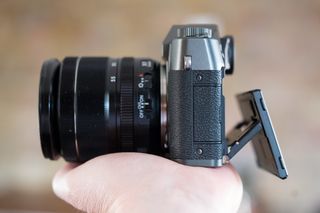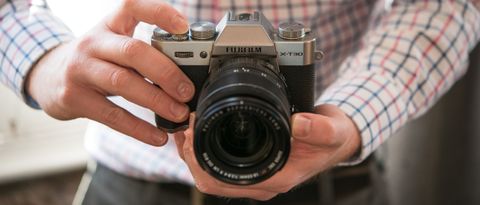Hands on: Fujifilm X-T30 review
EARLY VERDICT
With so much of the X-T3 squeezed inside a smaller, lighter and more affordable body, the X-T30 looks a strong contender in the mid-range mirrorless market. With so much focus from other corners on full-frame systems, the X-T30 also has fewer direct competitors – at least for now.
FOR
- Strong feature set
- Tiny and light body
- Rugged build and handsome design
- AF appears to work well
AGAINST
- LCD is less flexible than others
- Viewfinder magnification is only 0.62x
- Grip is a little small
- No sensor-based image stablization
While Fujifilm’s X-T3 and X-Pro2 models are perhaps the better-known cameras in the X-series, the company has stated that the X-T20 has been its best-selling camera to date.
Fujifilm X-T30: features
- 26.1MP X-Trans CMOS 4 sensor
- X-Processor 4 engine
- 4K DCI and UHD recording, plus Eterna mode
The key change between the X-T30 and the model it updates is that the new arrival makes use of the same 26.1MP X-Trans 4 CMOS sensor as the X-T3, and partners it with the X-Processor 4 that also featured in that model.
On paper, the increase in resolution from the X-T20's 24.3MP sensor may not sound like much, but with a back-illuminated design and stronger processing power, we should expect improvements to both image quality and overall performance.
This combination also allows for 4K capture in both DCI and UHD options, which further benefits from the same 6K oversampling at the time of capture as the X-T3, to deliver better-quality footage.
While the X-T30 maintains the 8fps burst shooting option from the X-T20, it can now be set to capture 20fps with its electronic shutter, rather than 14fps as on its predecessor. If you're happy to crop into the center of the frame by a factor of 1.25x, however, you can increase this to 30fps by calling on the previously seen Sports Finder mode, with images output at 16MP.
Other key changes concern the autofocusing and face detection systems. With the same sensor and processing partnership as the X-T3, the camera now sports 2.16 million phase-detect AF pixels on the sensor, enabling the X-T30's AF system to be rated to -3EV at the lower end of the range, compared to the X-T20's -1EV. Meanwhile, the Face Detection system is now said to detect smaller faces in the frame, and offer greater stability as the subject moves around, and better adherence to the subject if an obstacle presents itself.
Fujifilm X-T30: build and handling
- New Focus lever
- Marginally slimmer body than X-T20
- Only 383g (same as X-T20)
Externally, little appears to have changed between the X-T20 and the X-T30. The most significant difference is at the back of the camera, where Fujifilm has decided to replace the D-pad that’s principally used to navigate menus with a lever control (which has forced the Q Menu button towards the edge of the camera).
While the lever is used to move through the menu system, it also provides a far more convenient way to adjust the focusing point. Furthermore, it takes up far less space than the D-pad, which in turn leaves more room for the thumb to rest without any obstructions.
This is a popular control, to the extent that leaving it out of a new camera is now always met with some criticism. Fujifilm has explained that this was included partly thanks to feedback from users of the X-E3, and that it wouldn’t be possible to include both the D-pad and focus lever without compromising on the size of the camera. In use, it moves just as well as we've experienced on other Fujifilm cameras bearing the same control, and the camera responds without any delays.
The menu system is fairly comprehensive, much more so than you might expect from a camera of this size, but when you consider just how much functionality from more senior models you’re getting here, you appreciate how necessary this is. Fortunately, we get the same clarity and logical structure in the menus as before, which means that even those new to the system should be able to get acquainted in no time.
The X-T30's body has been made 1.3mm slimmer than the X-T20’s, thanks to a thinner LCD screen. Yet, despite a handful of physical changes, the camera weighs precisely the same as the X-T20: 383g with a memory card and battery in place. It’s certainly now at the point where it doesn’t feel as though Fujifilm would be able to make the camera any smaller without compromising handling and operation.
The changes made here are also now said to enhance the grip, which has been gently restyled from the X-T20 to allow for better support when using heavier lenses, although personally we'd prefer to see something a little more substantial. Handling is always subjective, but in average-sized hands the grip just feels a little small, and a touch too far down the front plate to allow for an ideal hold.
The camera appears nicely balanced with the XF 18-55mm f/2.8-4 R LM OIS we got to use, although those wanting something even more portable can pair it with either the XC 15-45mm f/3.5-5.6 OIS PZ lens, or one of Fujifim’s more compact primes. It seems unlikely that the camera would provide enough support for one of the beefier lenses in the XF stable (something Fujifilm has apparently sought to improve for this model), but then its primary audience is less likely to opt for these. That said, with so much of the X-T3’s spec sheet on board, it will obviously have appeal as a backup body to more advanced users, perhaps those with an X-T3 or X-H1.
Fujifilm X-T30: LCD and viewfinder
- 3-inch touchscreen LCD, 1.04 million dots
- 2.36 millon-dot EVF, 0.62x magnification
- LCD screen tilts up and down
The LCD screen is nice and clear, and appears to respond well to touch, whether you’re selecting the focusing point or adjusting settings in the Q Menu or something else. It’s arguably a fraction less sensitive than those on some other systems, although this isn’t always a bad thing, as it can prevent accidental brushes that end up sending the focusing point across the frame. Indeed, Fujifilm has stated that the revised design provides better separation between the back of the camera and the EVF’s eye point than on the X-T20.
That said, in our brief time with the model, unwanted presses of the touchscreen did occur on a couple of occasions. It seems this will always to be an issue with touchscreens to some extent – and, of course, this isn't specific to Fujifilm. The only other minor frustration with the screen on the X-T30 is with the control on the right-hand side of the display that’s used to enable and disable touchscreen focusing, which is so painfully small that it can be difficult to key properly.

The viewfinder is now said to be brighter than before, although the company claims that thanks to the updated processing engine this has had no ill effect on battery life. In fact, battery life is slightly better on the new model.
In use, the viewfinder certainly appeared to be nice and bright in the conditions in which we tested it. Outdoors, in high-contrast conditions, its electronic nature becomes more obvious as contrast increases, but this would be true of many similar viewfinders.
One thing that may irk some is the finder’s magnification, which is 0.62x in 35mm terms. This is less generous than on rival models such as the Sony a6400(0.7x) and Panasonic GX9 (also 0.7x), although it’s on a par with the Olympus PEN-F (0.62x). It's not something that's a huge issue in itself, as the viewfinder is still very nice to use, but it's still one area where the camera falls a little behind some of its peers.
Fujifilm X-T30: early verdict
The X-T30 wasn't a difficult model to predict, and the specs inherited from the X-T3 make this a compelling proposition for casual users with a little more money to spend, or those looking for an upgrade from older X-series models. While the X-T3 does still retain a handful of advantages – and will gain some of the newer functionality through a forthcoming firmware update – the X-T30 has a stronger balance between specs and price, with a smaller and lighter body to recommend it even further over its big brother.
Handling is generally very good, and the adoption of the focus lever will no doubt make a lot of people happy. There's little to grumble about in terms of operation too, with fine response from the physical controls and plenty to customize and tweak through the clear and comprehensive menu system. We're not entirely convinced that model is large enough to provide sufficient support for heavier optics, but then Fujifilm needs to strike a balance between this and catering for the majority of users who will be using more everyday lenses most of the time.
While there are a few areas in which competitors have an advantage, the fact that Fujifilm has used the same sensor and processor as the X-T3 is significant. This respected marriage works brilliantly in the X-T3, so the prospect of getting it inside an even more portable package is great news. We'll have to wait for a full production sample to find out if the camera works as well as we imagine – but we certainly like what we've seen so far.






Comments
Post a Comment